Enterprise Architecture Report: HP's Framework and Strategic Map
VerifiedAdded on 2023/06/05
|9
|2054
|215
Report
AI Summary
This report provides an in-depth analysis of Hewlett-Packard's (HP) Enterprise Architecture, focusing on the Zachman Framework and strategic map in the context of the merger with Compaq. The introduction outlines HP's position as a leading IT company and the challenges of integrating operations post-merger. The identification section highlights the need for consolidation to improve efficiency and shareholder value. The analysis delves into the restructuring efforts in Norway, including the use of Accenture to facilitate integration, and the objectives of Enterprise Architecture (EA) to create a unified IT environment. The design section presents the Zachman Framework, detailing its application to HP's business, and a strategic map encompassing financial, customer, internal process, and learning & growth perspectives. The justification emphasizes the advantages of the Zachman Framework, such as its acceptance as a standard for EA development and its ability to convey business models to stakeholders. The conclusion reinforces the framework's role in guiding complex technical and methodological decisions within HP. The report references various sources, including journal articles and books, to support its analysis. This assignment is contributed by a student to be published on the website Desklib. Desklib is a platform which provides all the necessary AI based study tools for students.
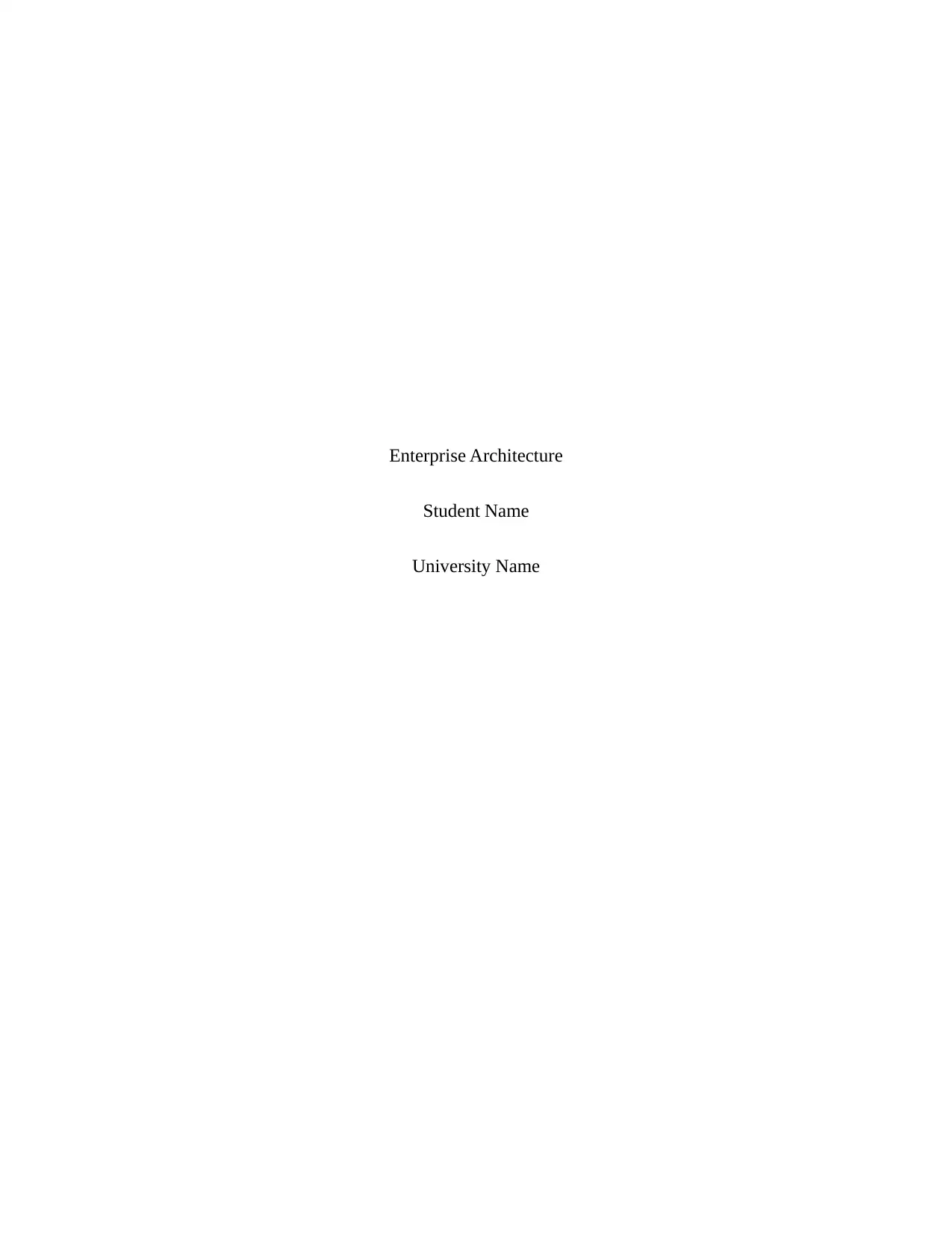
Enterprise Architecture
Student Name
University Name
Student Name
University Name
Paraphrase This Document
Need a fresh take? Get an instant paraphrase of this document with our AI Paraphraser
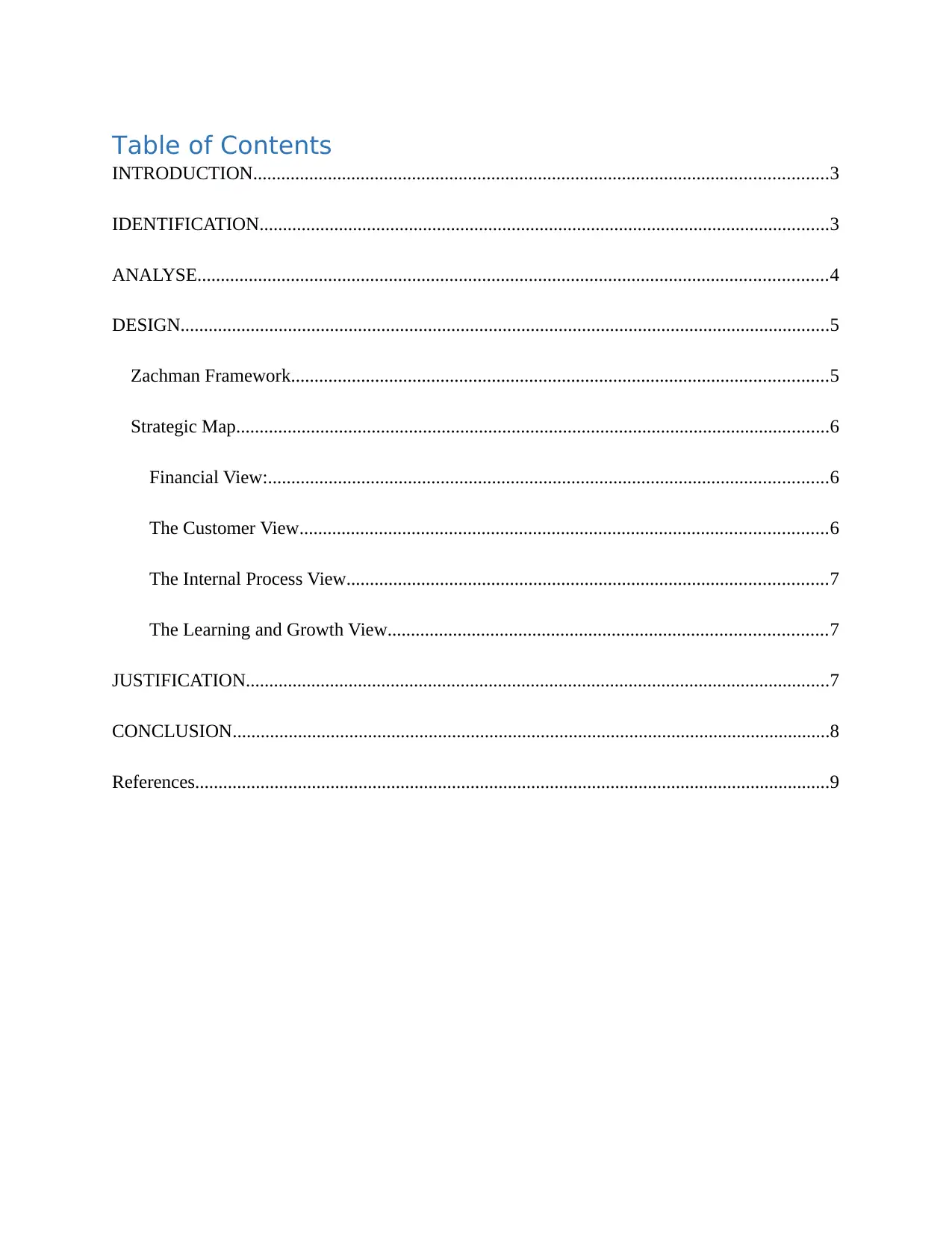
Table of Contents
INTRODUCTION...........................................................................................................................3
IDENTIFICATION..........................................................................................................................3
ANALYSE.......................................................................................................................................4
DESIGN...........................................................................................................................................5
Zachman Framework...................................................................................................................5
Strategic Map...............................................................................................................................6
Financial View:........................................................................................................................6
The Customer View.................................................................................................................6
The Internal Process View.......................................................................................................7
The Learning and Growth View..............................................................................................7
JUSTIFICATION.............................................................................................................................7
CONCLUSION................................................................................................................................8
References........................................................................................................................................9
INTRODUCTION...........................................................................................................................3
IDENTIFICATION..........................................................................................................................3
ANALYSE.......................................................................................................................................4
DESIGN...........................................................................................................................................5
Zachman Framework...................................................................................................................5
Strategic Map...............................................................................................................................6
Financial View:........................................................................................................................6
The Customer View.................................................................................................................6
The Internal Process View.......................................................................................................7
The Learning and Growth View..............................................................................................7
JUSTIFICATION.............................................................................................................................7
CONCLUSION................................................................................................................................8
References........................................................................................................................................9
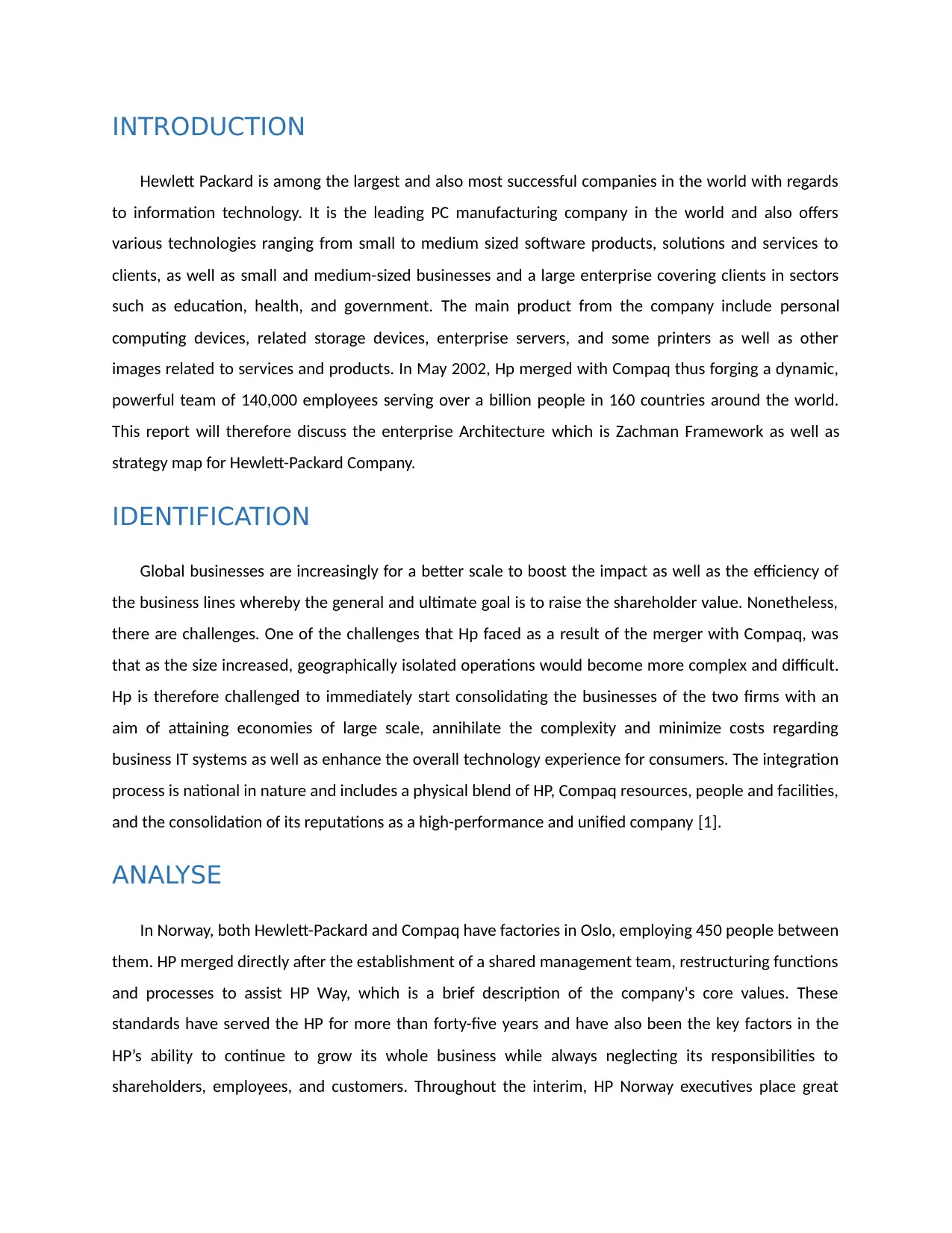
INTRODUCTION
Hewlett Packard is among the largest and also most successful companies in the world with regards
to information technology. It is the leading PC manufacturing company in the world and also offers
various technologies ranging from small to medium sized software products, solutions and services to
clients, as well as small and medium-sized businesses and a large enterprise covering clients in sectors
such as education, health, and government. The main product from the company include personal
computing devices, related storage devices, enterprise servers, and some printers as well as other
images related to services and products. In May 2002, Hp merged with Compaq thus forging a dynamic,
powerful team of 140,000 employees serving over a billion people in 160 countries around the world.
This report will therefore discuss the enterprise Architecture which is Zachman Framework as well as
strategy map for Hewlett-Packard Company.
IDENTIFICATION
Global businesses are increasingly for a better scale to boost the impact as well as the efficiency of
the business lines whereby the general and ultimate goal is to raise the shareholder value. Nonetheless,
there are challenges. One of the challenges that Hp faced as a result of the merger with Compaq, was
that as the size increased, geographically isolated operations would become more complex and difficult.
Hp is therefore challenged to immediately start consolidating the businesses of the two firms with an
aim of attaining economies of large scale, annihilate the complexity and minimize costs regarding
business IT systems as well as enhance the overall technology experience for consumers. The integration
process is national in nature and includes a physical blend of HP, Compaq resources, people and facilities,
and the consolidation of its reputations as a high-performance and unified company [1].
ANALYSE
In Norway, both Hewlett-Packard and Compaq have factories in Oslo, employing 450 people between
them. HP merged directly after the establishment of a shared management team, restructuring functions
and processes to assist HP Way, which is a brief description of the company's core values. These
standards have served the HP for more than forty-five years and have also been the key factors in the
HP’s ability to continue to grow its whole business while always neglecting its responsibilities to
shareholders, employees, and customers. Throughout the interim, HP Norway executives place great
Hewlett Packard is among the largest and also most successful companies in the world with regards
to information technology. It is the leading PC manufacturing company in the world and also offers
various technologies ranging from small to medium sized software products, solutions and services to
clients, as well as small and medium-sized businesses and a large enterprise covering clients in sectors
such as education, health, and government. The main product from the company include personal
computing devices, related storage devices, enterprise servers, and some printers as well as other
images related to services and products. In May 2002, Hp merged with Compaq thus forging a dynamic,
powerful team of 140,000 employees serving over a billion people in 160 countries around the world.
This report will therefore discuss the enterprise Architecture which is Zachman Framework as well as
strategy map for Hewlett-Packard Company.
IDENTIFICATION
Global businesses are increasingly for a better scale to boost the impact as well as the efficiency of
the business lines whereby the general and ultimate goal is to raise the shareholder value. Nonetheless,
there are challenges. One of the challenges that Hp faced as a result of the merger with Compaq, was
that as the size increased, geographically isolated operations would become more complex and difficult.
Hp is therefore challenged to immediately start consolidating the businesses of the two firms with an
aim of attaining economies of large scale, annihilate the complexity and minimize costs regarding
business IT systems as well as enhance the overall technology experience for consumers. The integration
process is national in nature and includes a physical blend of HP, Compaq resources, people and facilities,
and the consolidation of its reputations as a high-performance and unified company [1].
ANALYSE
In Norway, both Hewlett-Packard and Compaq have factories in Oslo, employing 450 people between
them. HP merged directly after the establishment of a shared management team, restructuring functions
and processes to assist HP Way, which is a brief description of the company's core values. These
standards have served the HP for more than forty-five years and have also been the key factors in the
HP’s ability to continue to grow its whole business while always neglecting its responsibilities to
shareholders, employees, and customers. Throughout the interim, HP Norway executives place great
⊘ This is a preview!⊘
Do you want full access?
Subscribe today to unlock all pages.

Trusted by 1+ million students worldwide
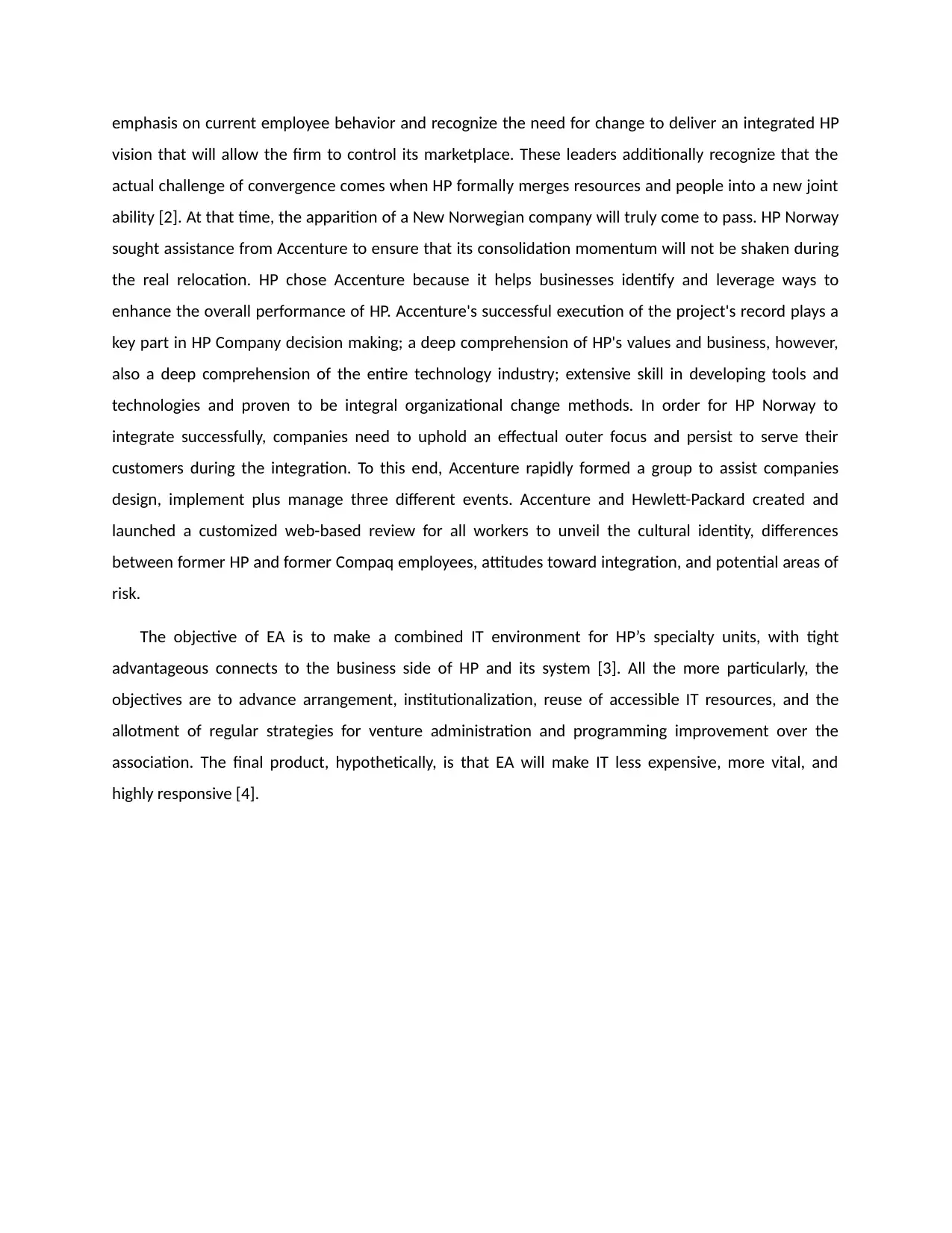
emphasis on current employee behavior and recognize the need for change to deliver an integrated HP
vision that will allow the firm to control its marketplace. These leaders additionally recognize that the
actual challenge of convergence comes when HP formally merges resources and people into a new joint
ability [2]. At that time, the apparition of a New Norwegian company will truly come to pass. HP Norway
sought assistance from Accenture to ensure that its consolidation momentum will not be shaken during
the real relocation. HP chose Accenture because it helps businesses identify and leverage ways to
enhance the overall performance of HP. Accenture's successful execution of the project's record plays a
key part in HP Company decision making; a deep comprehension of HP's values and business, however,
also a deep comprehension of the entire technology industry; extensive skill in developing tools and
technologies and proven to be integral organizational change methods. In order for HP Norway to
integrate successfully, companies need to uphold an effectual outer focus and persist to serve their
customers during the integration. To this end, Accenture rapidly formed a group to assist companies
design, implement plus manage three different events. Accenture and Hewlett-Packard created and
launched a customized web-based review for all workers to unveil the cultural identity, differences
between former HP and former Compaq employees, attitudes toward integration, and potential areas of
risk.
The objective of EA is to make a combined IT environment for HP’s specialty units, with tight
advantageous connects to the business side of HP and its system [3]. All the more particularly, the
objectives are to advance arrangement, institutionalization, reuse of accessible IT resources, and the
allotment of regular strategies for venture administration and programming improvement over the
association. The final product, hypothetically, is that EA will make IT less expensive, more vital, and
highly responsive [4].
vision that will allow the firm to control its marketplace. These leaders additionally recognize that the
actual challenge of convergence comes when HP formally merges resources and people into a new joint
ability [2]. At that time, the apparition of a New Norwegian company will truly come to pass. HP Norway
sought assistance from Accenture to ensure that its consolidation momentum will not be shaken during
the real relocation. HP chose Accenture because it helps businesses identify and leverage ways to
enhance the overall performance of HP. Accenture's successful execution of the project's record plays a
key part in HP Company decision making; a deep comprehension of HP's values and business, however,
also a deep comprehension of the entire technology industry; extensive skill in developing tools and
technologies and proven to be integral organizational change methods. In order for HP Norway to
integrate successfully, companies need to uphold an effectual outer focus and persist to serve their
customers during the integration. To this end, Accenture rapidly formed a group to assist companies
design, implement plus manage three different events. Accenture and Hewlett-Packard created and
launched a customized web-based review for all workers to unveil the cultural identity, differences
between former HP and former Compaq employees, attitudes toward integration, and potential areas of
risk.
The objective of EA is to make a combined IT environment for HP’s specialty units, with tight
advantageous connects to the business side of HP and its system [3]. All the more particularly, the
objectives are to advance arrangement, institutionalization, reuse of accessible IT resources, and the
allotment of regular strategies for venture administration and programming improvement over the
association. The final product, hypothetically, is that EA will make IT less expensive, more vital, and
highly responsive [4].
Paraphrase This Document
Need a fresh take? Get an instant paraphrase of this document with our AI Paraphraser
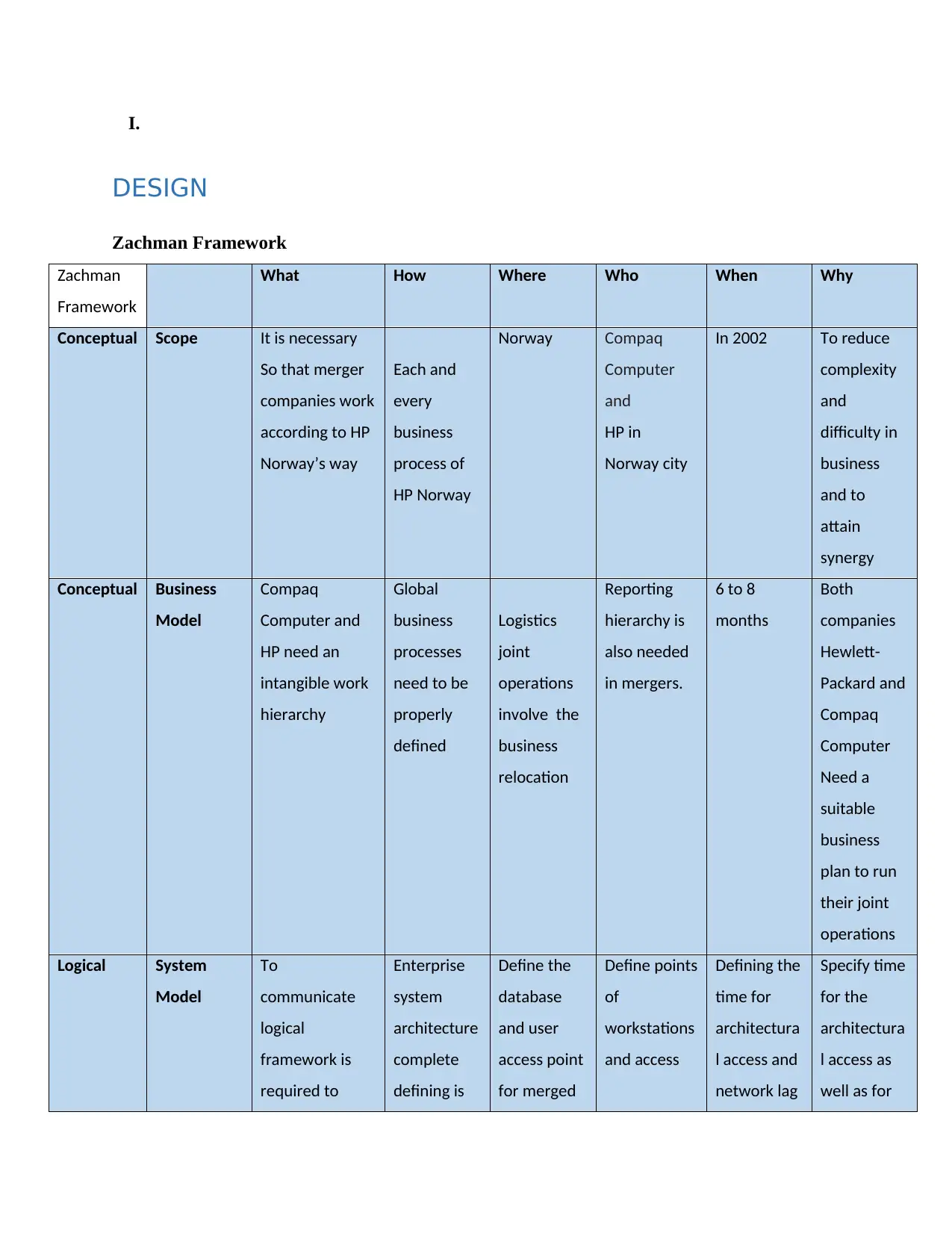
I.
DESIGN
Zachman Framework
Zachman
Framework
What How Where Who When Why
Conceptual Scope It is necessary
So that merger
companies work
according to HP
Norway’s way
Each and
every
business
process of
HP Norway
Norway Compaq
Computer
and
HP in
Norway city
In 2002 To reduce
complexity
and
difficulty in
business
and to
attain
synergy
Conceptual Business
Model
Compaq
Computer and
HP need an
intangible work
hierarchy
Global
business
processes
need to be
properly
defined
Logistics
joint
operations
involve the
business
relocation
Reporting
hierarchy is
also needed
in mergers.
6 to 8
months
Both
companies
Hewlett-
Packard and
Compaq
Computer
Need a
suitable
business
plan to run
their joint
operations
Logical System
Model
To
communicate
logical
framework is
required to
Enterprise
system
architecture
complete
defining is
Define the
database
and user
access point
for merged
Define points
of
workstations
and access
Defining the
time for
architectura
l access and
network lag
Specify time
for the
architectura
l access as
well as for
DESIGN
Zachman Framework
Zachman
Framework
What How Where Who When Why
Conceptual Scope It is necessary
So that merger
companies work
according to HP
Norway’s way
Each and
every
business
process of
HP Norway
Norway Compaq
Computer
and
HP in
Norway city
In 2002 To reduce
complexity
and
difficulty in
business
and to
attain
synergy
Conceptual Business
Model
Compaq
Computer and
HP need an
intangible work
hierarchy
Global
business
processes
need to be
properly
defined
Logistics
joint
operations
involve the
business
relocation
Reporting
hierarchy is
also needed
in mergers.
6 to 8
months
Both
companies
Hewlett-
Packard and
Compaq
Computer
Need a
suitable
business
plan to run
their joint
operations
Logical System
Model
To
communicate
logical
framework is
required to
Enterprise
system
architecture
complete
defining is
Define the
database
and user
access point
for merged
Define points
of
workstations
and access
Defining the
time for
architectura
l access and
network lag
Specify time
for the
architectura
l access as
well as for
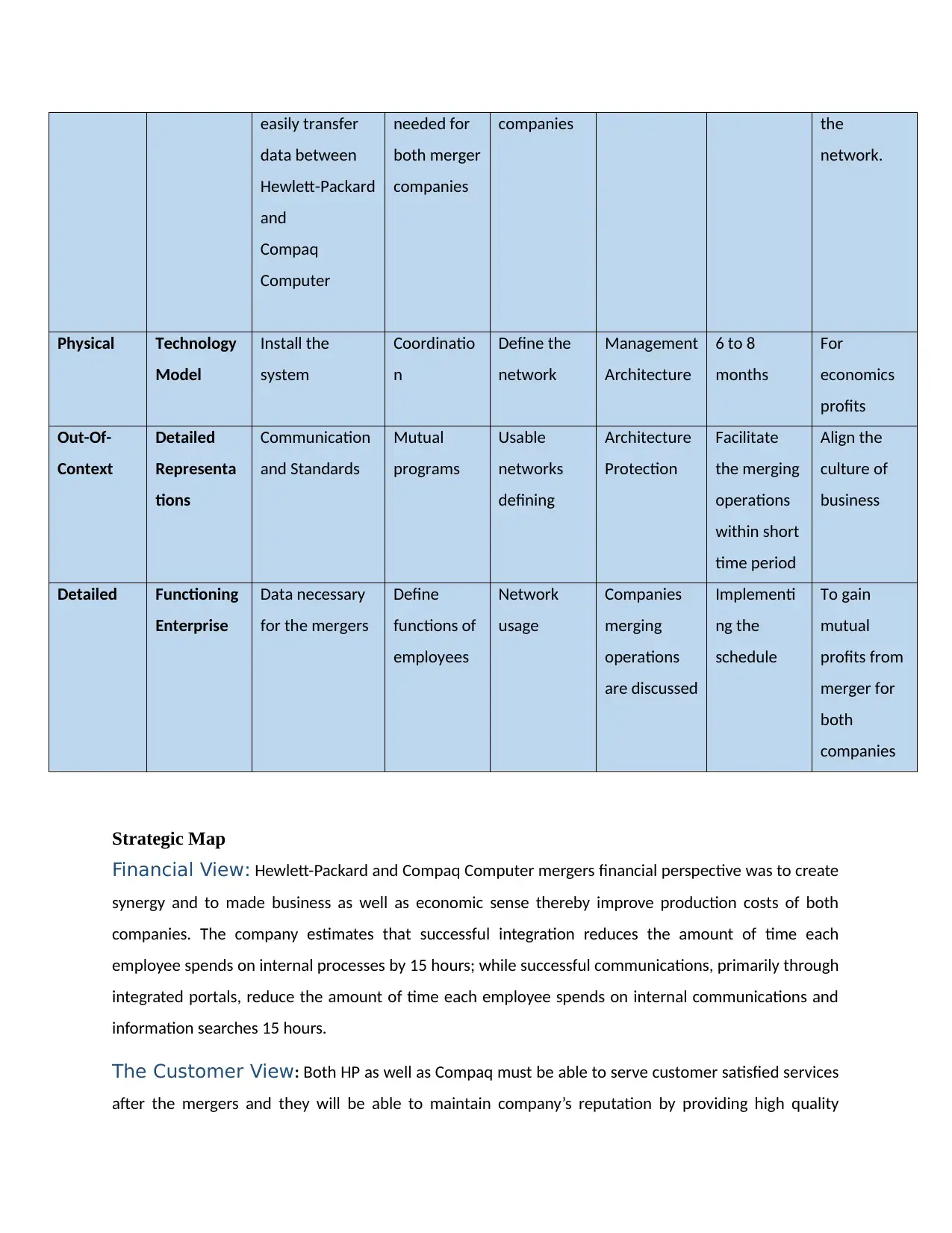
easily transfer
data between
Hewlett-Packard
and
Compaq
Computer
needed for
both merger
companies
companies the
network.
Physical Technology
Model
Install the
system
Coordinatio
n
Define the
network
Management
Architecture
6 to 8
months
For
economics
profits
Out-Of-
Context
Detailed
Representa
tions
Communication
and Standards
Mutual
programs
Usable
networks
defining
Architecture
Protection
Facilitate
the merging
operations
within short
time period
Align the
culture of
business
Detailed Functioning
Enterprise
Data necessary
for the mergers
Define
functions of
employees
Network
usage
Companies
merging
operations
are discussed
Implementi
ng the
schedule
To gain
mutual
profits from
merger for
both
companies
Strategic Map
Financial View: Hewlett-Packard and Compaq Computer mergers financial perspective was to create
synergy and to made business as well as economic sense thereby improve production costs of both
companies. The company estimates that successful integration reduces the amount of time each
employee spends on internal processes by 15 hours; while successful communications, primarily through
integrated portals, reduce the amount of time each employee spends on internal communications and
information searches 15 hours.
The Customer View: Both HP as well as Compaq must be able to serve customer satisfied services
after the mergers and they will be able to maintain company’s reputation by providing high quality
data between
Hewlett-Packard
and
Compaq
Computer
needed for
both merger
companies
companies the
network.
Physical Technology
Model
Install the
system
Coordinatio
n
Define the
network
Management
Architecture
6 to 8
months
For
economics
profits
Out-Of-
Context
Detailed
Representa
tions
Communication
and Standards
Mutual
programs
Usable
networks
defining
Architecture
Protection
Facilitate
the merging
operations
within short
time period
Align the
culture of
business
Detailed Functioning
Enterprise
Data necessary
for the mergers
Define
functions of
employees
Network
usage
Companies
merging
operations
are discussed
Implementi
ng the
schedule
To gain
mutual
profits from
merger for
both
companies
Strategic Map
Financial View: Hewlett-Packard and Compaq Computer mergers financial perspective was to create
synergy and to made business as well as economic sense thereby improve production costs of both
companies. The company estimates that successful integration reduces the amount of time each
employee spends on internal processes by 15 hours; while successful communications, primarily through
integrated portals, reduce the amount of time each employee spends on internal communications and
information searches 15 hours.
The Customer View: Both HP as well as Compaq must be able to serve customer satisfied services
after the mergers and they will be able to maintain company’s reputation by providing high quality
⊘ This is a preview!⊘
Do you want full access?
Subscribe today to unlock all pages.

Trusted by 1+ million students worldwide
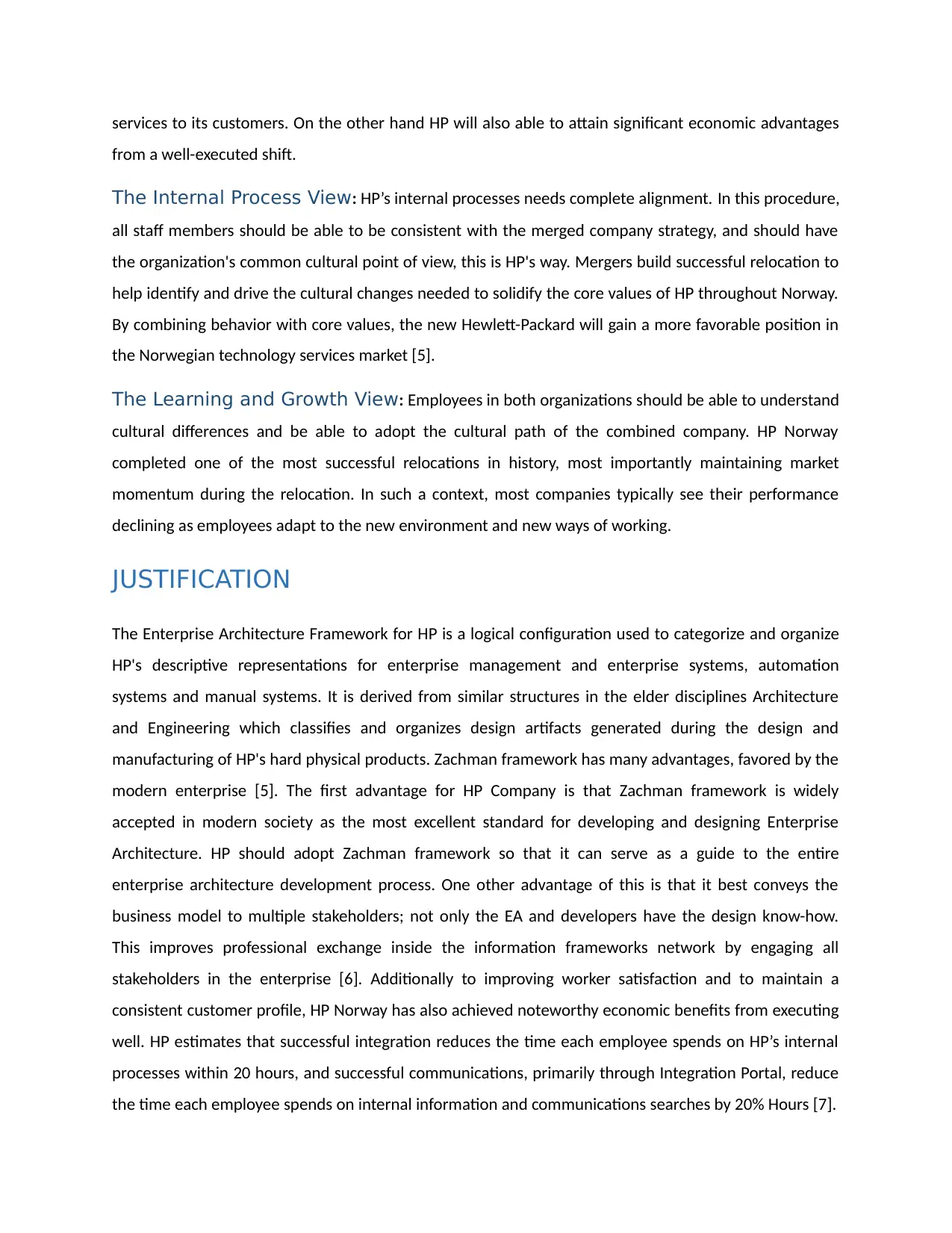
services to its customers. On the other hand HP will also able to attain significant economic advantages
from a well-executed shift.
The Internal Process View: HP’s internal processes needs complete alignment. In this procedure,
all staff members should be able to be consistent with the merged company strategy, and should have
the organization's common cultural point of view, this is HP's way. Mergers build successful relocation to
help identify and drive the cultural changes needed to solidify the core values of HP throughout Norway.
By combining behavior with core values, the new Hewlett-Packard will gain a more favorable position in
the Norwegian technology services market [5].
The Learning and Growth View: Employees in both organizations should be able to understand
cultural differences and be able to adopt the cultural path of the combined company. HP Norway
completed one of the most successful relocations in history, most importantly maintaining market
momentum during the relocation. In such a context, most companies typically see their performance
declining as employees adapt to the new environment and new ways of working.
JUSTIFICATION
The Enterprise Architecture Framework for HP is a logical configuration used to categorize and organize
HP's descriptive representations for enterprise management and enterprise systems, automation
systems and manual systems. It is derived from similar structures in the elder disciplines Architecture
and Engineering which classifies and organizes design artifacts generated during the design and
manufacturing of HP's hard physical products. Zachman framework has many advantages, favored by the
modern enterprise [5]. The first advantage for HP Company is that Zachman framework is widely
accepted in modern society as the most excellent standard for developing and designing Enterprise
Architecture. HP should adopt Zachman framework so that it can serve as a guide to the entire
enterprise architecture development process. One other advantage of this is that it best conveys the
business model to multiple stakeholders; not only the EA and developers have the design know-how.
This improves professional exchange inside the information frameworks network by engaging all
stakeholders in the enterprise [6]. Additionally to improving worker satisfaction and to maintain a
consistent customer profile, HP Norway has also achieved noteworthy economic benefits from executing
well. HP estimates that successful integration reduces the time each employee spends on HP’s internal
processes within 20 hours, and successful communications, primarily through Integration Portal, reduce
the time each employee spends on internal information and communications searches by 20% Hours [7].
from a well-executed shift.
The Internal Process View: HP’s internal processes needs complete alignment. In this procedure,
all staff members should be able to be consistent with the merged company strategy, and should have
the organization's common cultural point of view, this is HP's way. Mergers build successful relocation to
help identify and drive the cultural changes needed to solidify the core values of HP throughout Norway.
By combining behavior with core values, the new Hewlett-Packard will gain a more favorable position in
the Norwegian technology services market [5].
The Learning and Growth View: Employees in both organizations should be able to understand
cultural differences and be able to adopt the cultural path of the combined company. HP Norway
completed one of the most successful relocations in history, most importantly maintaining market
momentum during the relocation. In such a context, most companies typically see their performance
declining as employees adapt to the new environment and new ways of working.
JUSTIFICATION
The Enterprise Architecture Framework for HP is a logical configuration used to categorize and organize
HP's descriptive representations for enterprise management and enterprise systems, automation
systems and manual systems. It is derived from similar structures in the elder disciplines Architecture
and Engineering which classifies and organizes design artifacts generated during the design and
manufacturing of HP's hard physical products. Zachman framework has many advantages, favored by the
modern enterprise [5]. The first advantage for HP Company is that Zachman framework is widely
accepted in modern society as the most excellent standard for developing and designing Enterprise
Architecture. HP should adopt Zachman framework so that it can serve as a guide to the entire
enterprise architecture development process. One other advantage of this is that it best conveys the
business model to multiple stakeholders; not only the EA and developers have the design know-how.
This improves professional exchange inside the information frameworks network by engaging all
stakeholders in the enterprise [6]. Additionally to improving worker satisfaction and to maintain a
consistent customer profile, HP Norway has also achieved noteworthy economic benefits from executing
well. HP estimates that successful integration reduces the time each employee spends on HP’s internal
processes within 20 hours, and successful communications, primarily through Integration Portal, reduce
the time each employee spends on internal information and communications searches by 20% Hours [7].
Paraphrase This Document
Need a fresh take? Get an instant paraphrase of this document with our AI Paraphraser
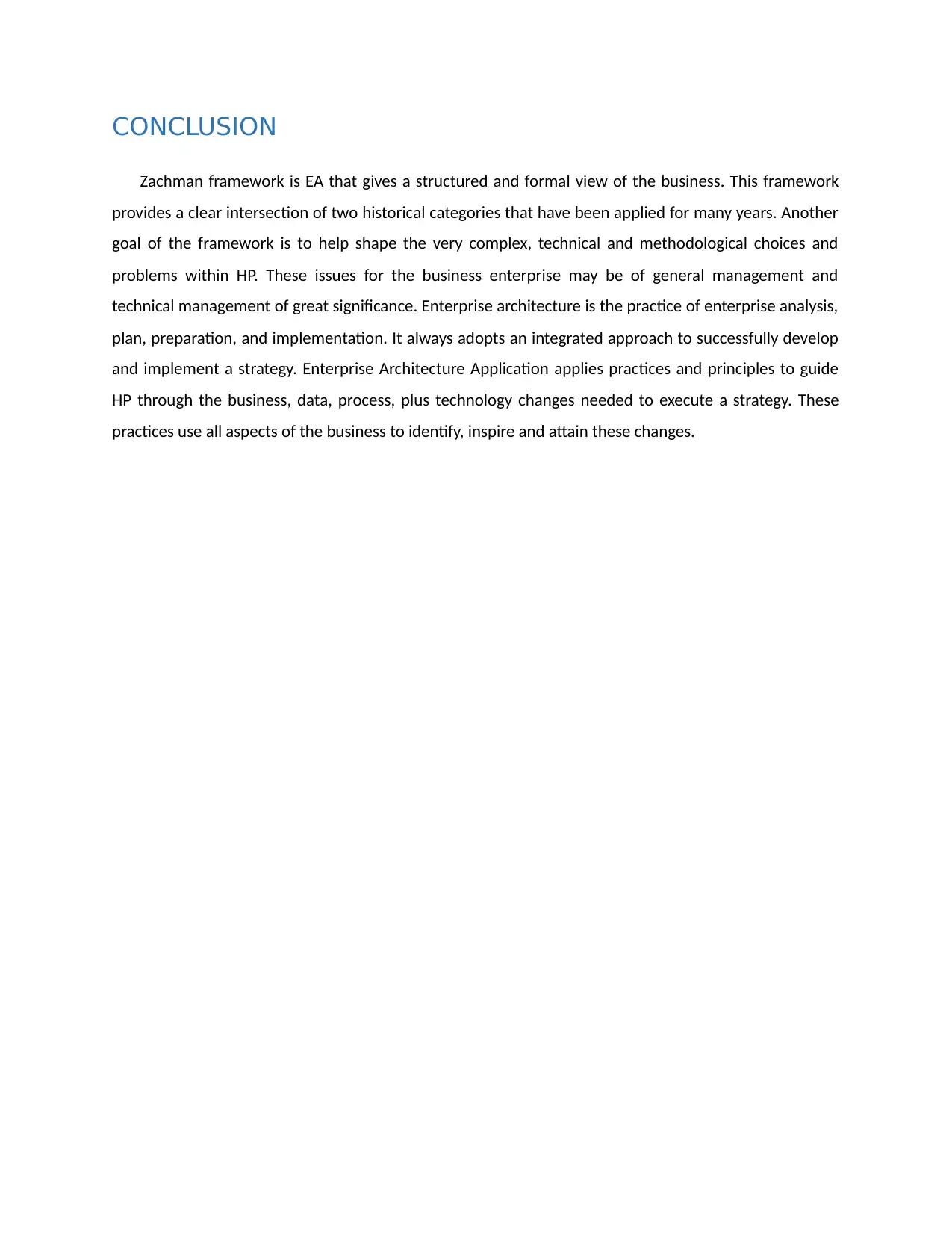
CONCLUSION
Zachman framework is EA that gives a structured and formal view of the business. This framework
provides a clear intersection of two historical categories that have been applied for many years. Another
goal of the framework is to help shape the very complex, technical and methodological choices and
problems within HP. These issues for the business enterprise may be of general management and
technical management of great significance. Enterprise architecture is the practice of enterprise analysis,
plan, preparation, and implementation. It always adopts an integrated approach to successfully develop
and implement a strategy. Enterprise Architecture Application applies practices and principles to guide
HP through the business, data, process, plus technology changes needed to execute a strategy. These
practices use all aspects of the business to identify, inspire and attain these changes.
Zachman framework is EA that gives a structured and formal view of the business. This framework
provides a clear intersection of two historical categories that have been applied for many years. Another
goal of the framework is to help shape the very complex, technical and methodological choices and
problems within HP. These issues for the business enterprise may be of general management and
technical management of great significance. Enterprise architecture is the practice of enterprise analysis,
plan, preparation, and implementation. It always adopts an integrated approach to successfully develop
and implement a strategy. Enterprise Architecture Application applies practices and principles to guide
HP through the business, data, process, plus technology changes needed to execute a strategy. These
practices use all aspects of the business to identify, inspire and attain these changes.
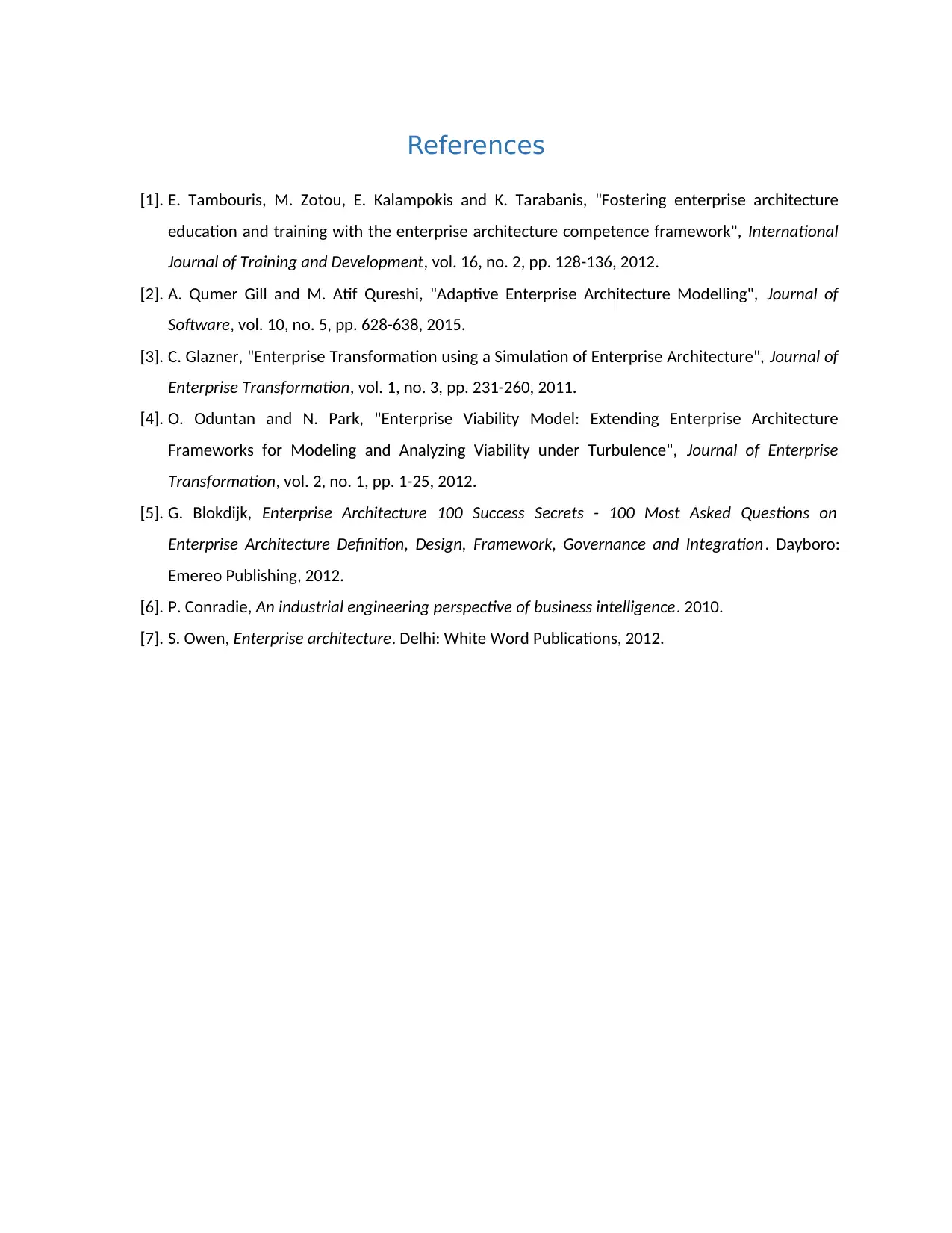
References
[1]. E. Tambouris, M. Zotou, E. Kalampokis and K. Tarabanis, "Fostering enterprise architecture
education and training with the enterprise architecture competence framework", International
Journal of Training and Development, vol. 16, no. 2, pp. 128-136, 2012.
[2]. A. Qumer Gill and M. Atif Qureshi, "Adaptive Enterprise Architecture Modelling", Journal of
Software, vol. 10, no. 5, pp. 628-638, 2015.
[3]. C. Glazner, "Enterprise Transformation using a Simulation of Enterprise Architecture", Journal of
Enterprise Transformation, vol. 1, no. 3, pp. 231-260, 2011.
[4]. O. Oduntan and N. Park, "Enterprise Viability Model: Extending Enterprise Architecture
Frameworks for Modeling and Analyzing Viability under Turbulence", Journal of Enterprise
Transformation, vol. 2, no. 1, pp. 1-25, 2012.
[5]. G. Blokdijk, Enterprise Architecture 100 Success Secrets - 100 Most Asked Questions on
Enterprise Architecture Definition, Design, Framework, Governance and Integration. Dayboro:
Emereo Publishing, 2012.
[6]. P. Conradie, An industrial engineering perspective of business intelligence. 2010.
[7]. S. Owen, Enterprise architecture. Delhi: White Word Publications, 2012.
[1]. E. Tambouris, M. Zotou, E. Kalampokis and K. Tarabanis, "Fostering enterprise architecture
education and training with the enterprise architecture competence framework", International
Journal of Training and Development, vol. 16, no. 2, pp. 128-136, 2012.
[2]. A. Qumer Gill and M. Atif Qureshi, "Adaptive Enterprise Architecture Modelling", Journal of
Software, vol. 10, no. 5, pp. 628-638, 2015.
[3]. C. Glazner, "Enterprise Transformation using a Simulation of Enterprise Architecture", Journal of
Enterprise Transformation, vol. 1, no. 3, pp. 231-260, 2011.
[4]. O. Oduntan and N. Park, "Enterprise Viability Model: Extending Enterprise Architecture
Frameworks for Modeling and Analyzing Viability under Turbulence", Journal of Enterprise
Transformation, vol. 2, no. 1, pp. 1-25, 2012.
[5]. G. Blokdijk, Enterprise Architecture 100 Success Secrets - 100 Most Asked Questions on
Enterprise Architecture Definition, Design, Framework, Governance and Integration. Dayboro:
Emereo Publishing, 2012.
[6]. P. Conradie, An industrial engineering perspective of business intelligence. 2010.
[7]. S. Owen, Enterprise architecture. Delhi: White Word Publications, 2012.
⊘ This is a preview!⊘
Do you want full access?
Subscribe today to unlock all pages.

Trusted by 1+ million students worldwide
1 out of 9
Related Documents
Your All-in-One AI-Powered Toolkit for Academic Success.
+13062052269
info@desklib.com
Available 24*7 on WhatsApp / Email
![[object Object]](/_next/static/media/star-bottom.7253800d.svg)
Unlock your academic potential
Copyright © 2020–2025 A2Z Services. All Rights Reserved. Developed and managed by ZUCOL.




